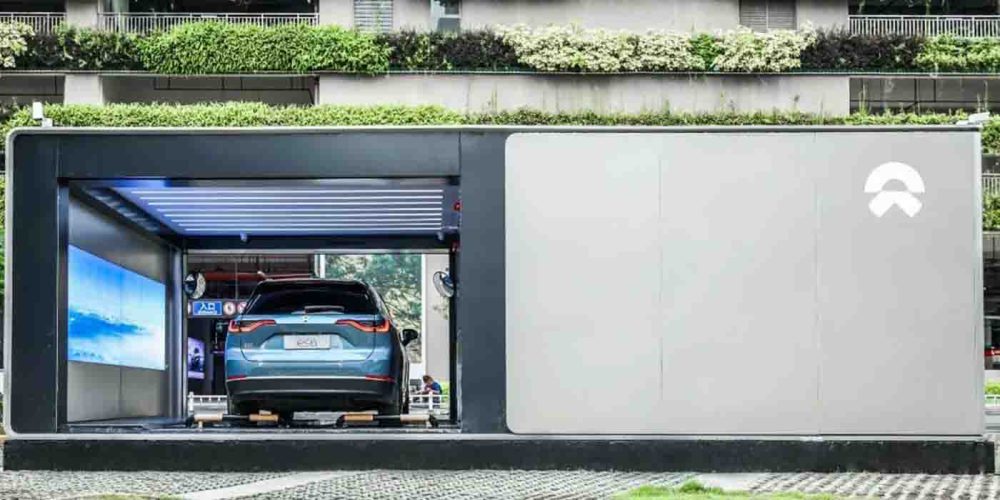
According to a recent Weibo post, EV automaker NIO is testing its latest generation of battery swap stations in China. Due to record temperature across the country causing energy blackouts, NIO has explained that some of its swap stations already have the technology equipped to act as “virtual power plants” supplying energy back to the local grid during peak hours.
NIO is a Chinese technology company specializing in premium EVs that are now starting to expand outside of China into new markets in Europe. In additional to providing an all-electric range of SUVs and sedans, NIO remains on the forefront of implementing battery swap technology to support its EVs.
The automaker currently has over 1,000 swap stations in China alone, and has begun implementing them in its newer markets overseas, and may even license the technology to other automakers as well.
During its “NIO Power Day” event held in early July, the automaker introduced its third-generation swap station which will deliver more battery capacity and a more flexible layout. At the time, NIO states that those stations are nearing their end of development and are being tested before installations begin in late 2022/early 2023.
NIO also shared that with its next-gen swap stations, it was already testing the use of stored batteries to provide power back to the grid below with plans to implement the technology into application scenarios in the future.
With its latest social media post, NIO has shared the progress of this swap station energy sharing technology, as well as its expansion goals in the future.

NIO tests “grid peak shaving” at over 100 swap stations
In response to large-scale power cuts in China to combat record high temperatures limiting the effectiveness of hydro and wind power, NIO has begun testing energy discharges back to local grids through its swap stations. In a recent Weibo post, the Chinese company explains it can help combat peak energy demands from people’s homes and the growing number of EVs on roads in two steps:
First, is to facilitate orderly charging at times for EV drivers specified by the demand on grid to “cut peaks and fill valleys.” NIO states that its “Energy Cloud” can mobilize charging and swapping resources to fully interact with the power grid, and charge during load valleys.
The second and potentially game-changing factor is to enable all NIO swap stations to participate in grid peak regulation, acting as a virtual power plants. NIO elaborates:
At this time, the advantages of the power station are extremely prominent. It can be directly connected to the dispatching center of the power grid through the private network, accept power grid dispatching instructions, achieve minute-level or even second-level power response, and efficiently participate in frequency regulation.
According to NIO, its current swap stations are equipped with thirteen battery packs, combining for a calculated energy storage capacity of 600-700 kWh at any time. When an EV driver replaces their battery at the station, the other ten or eleven packs can then be discharged to the grid for five to ten minutes, and discharge to the grid, which hardly interrupts the normal battery replacement services.
NIO shared that it already began testing this energy grid discharge with fifteen swap stations in Hefei. Without affecting NIO users’ normal power exchange use, the power load of this fifteen unit virtual power plant had been adjusted by 8 MWh in five days, equivalent to saving real-time power consumption for over 3,000 ordinary households.
When the Heifei power dispatching control center issued an order to the fiften NIO swap stations to discharge energy to the grid, the load was reduced by 1.4% within one minute, while the average power of a given station in the group was only reduced by 100 kW, allowing for battery pack charging to continue.
To help further reduce grid demand during China’s hot summer, NIO shared additional swap stations testing energy discharges back to grids in other cities:
- 22 swap stations in Guangdong
- 58 in Shanghai
- 8 in Zhejiang
- 7 in Nanjing
- A total of 108 swap stations have participated in the grid peak shaving response in their respective cities.
In addition to sending energy back, NIO shared that of its 1,067 battery swap stations in the country, 575 battery have participated in staggered charging, aiding the proportion of electricity consumption in energy valleys to increase from 12% to 20%, while peak electricity consumption was transferred to 4.1 million kWh over a span of 30 days.
Looking ahead, NIO said it plans to expand grid response and off-peak charging to more swap stations in other regions of the country, especially where there are more clean energy sources. Reverse energy discharge to the power grid will also be put into trial operation, assumingely in the aforementioned 3rd-generation swap stations later this year.
Subscribe to Electrek on YouTube for exclusive videos and subscribe to the podcast.
Author: Scooter Doll
Source: Electrek



